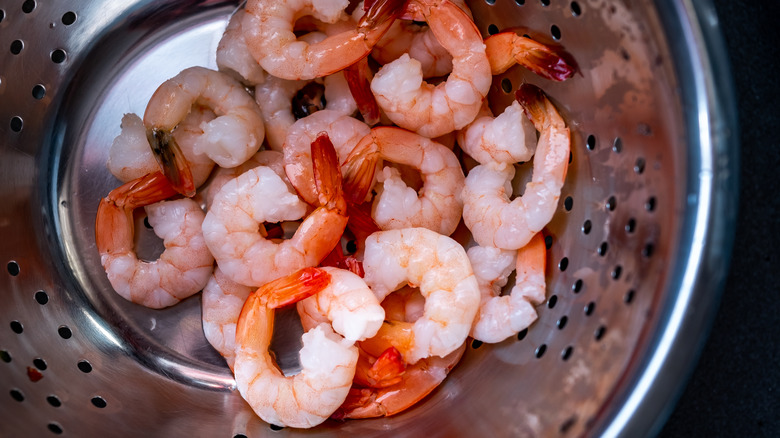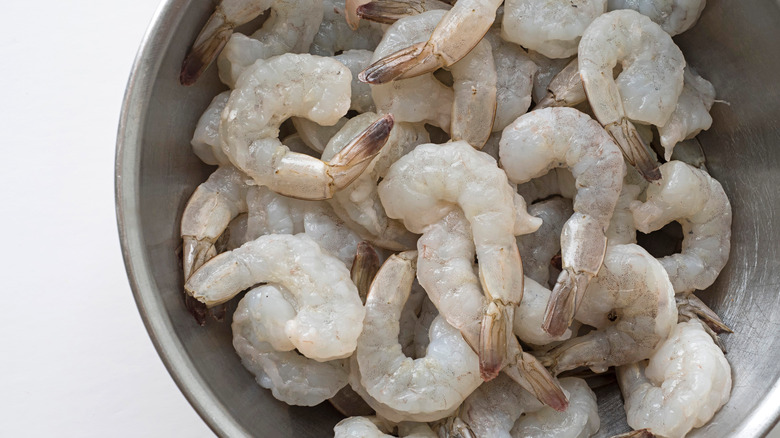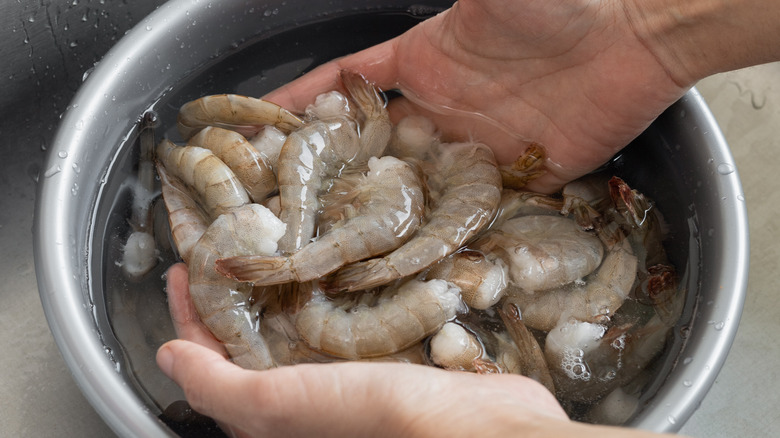What You Need To Know Before Rinsing Fresh Shrimp
These days, there's no food safety reason to rinse store-bought shrimp and a load of tiny, invisible reasons not to. But rinsing shrimp — or indeed, meat in general — can be a contentious topic.
The U.S. Department of Health & Human Services continues to shout from the rooftops strongly recommend against washing meat, poultry, or seafood of any kind. And they aren't alone. The U.S. Department of Agriculture notes that rinsing or washing animal proteins like shrimp just spreads bacteria — some of which can be pretty serious — to your sink, the countertops, any utensils you use, anything in the sink, and potentially anything within the three-foot splash zone.
According to the U.S. government, if you suspect your shrimp is bad, you shouldn't eat it at all. Rinsing it might remove some of that telltale fishy smell in any juices that have formed around the shrimp, but the only way to kill bacteria is to cook it. Unfortunately, it's not so simple. There are religious, cultural, and practical reasons to rinse meat, including shrimp. Ultimately, you're in charge of whether your shrimp go for a final swim. But you should make that decision armed with the facts.
Why not rinse raw shrimp?
A 2015 study that appeared in Letters in Applied Microbiology notes that 55% of almost 300 shrimp samples scientists tested contained a dangerous bacteria called vibrio, which can cause gastritis, cholera, and (potentially flesh-eating) infections. Some of those strains were even (eek!) antibiotic-resistant. And that's the bacteria they're worried you could spread. It won't wash off, and the only way to kill it is to cook it to 145 degrees Fahrenheit for at least 15 seconds.
Fortunately, modern life offers ways to keep shrimp safe to eat until we're ready, at least for a couple of days (thanks fridge!). And our seafood typically comes to us indirectly — not straight from the ocean, but from processors who already cleaned it.
The problem with scientists' advice to avoid rinsing shrimp lest we die a thousand terrible deaths is that shrimp is specifically a bit different from other animal proteins that come into our kitchen in that it sometimes comes into our kitchen whole.
What to do if you must rinse shrimp
Many recipes call for whole shrimp to be peeled and deveined. You can safely eat those bits, but you may want to get rid of them since the shell is hard and sharp and the veins can be gritty. You can wipe away any leftover bits of peel or digestive tract (because that's what it is) with a clean towel, but you'd be forgiven for feeling like that's not enough. Besides, if your shrimp recipe calls for brining or you have any cultural or religious practices that require brine-like treatments, you may have to rinse it off, anyway.
To do that safely, clear your sink and up to 3 feet from the surrounding area. Move dish towels, dishes, and gadgets so they don't get covered with shrimpy bacteria. Run cold water gently to avoid creating a lot of splashes and place the shrimp under it. A colander or mesh sieve is handy for this task. When you're done, wash your hands thoroughly, then, clean any utensils and the sink with antibacterial soap and water, disinfect the surrounding area, and wash your hands again.
When you're done, your shrimp are ready to cook any way you'd like them. But for safety and the sake of the sanity of those who work in relevant government agencies who are trying so hard to make sure we all know, you still have to cook them to the right temperature.


